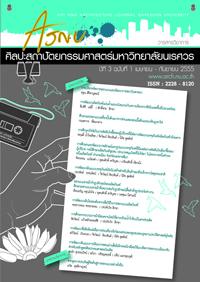การพัฒนาผลิตภัณฑ์แผ่นฝ้าและผนังฉนวนกันความร้อนจากพืชในเขตพื้นที่ประเทศไทย
Main Article Content
Abstract
งานวิจัยนี้เป็นการศึกษากระบวนการผลิต และสมบัติของแผ่นฝ้าและผนังฉนวนกันความร้อนจากพืชในเขตพื้นที่ประเทศไทย ซึ่งมีวัตถุประสงค์วิจัย 2 ประการ คือ 1. เพื่อศึกษาคุณสมบัติของเส้นใยพืชในเขตพื้นที่ประเทศไทย ที่เหมาะสมในการพัฒนาและกระบวนการผลิตด้วยวิธีการต่างๆ เช่น การขึ้นรูปวัสดุจากพืชเป็นแผ่นฝ้าและผนังฉนวนกันความร้อน 2. เพื่อพัฒนาผลิตภัณฑ์แผ่นฝ้าและผนังฉนวนกันความร้อนจากพืช โดยให้ความสำคัญกับการอนุรักษ์พลังงานและสิ่งแวดล้อม
ผลการวิจัยพบว่า
1. ด้านการศึกษาคุณลักษณะของเส้นใย พบว่า หญ้าค้า ธูปฤๅษีและกระถินยักษ์ มีความเหนียวอยู่ในตัวมีความเหมาะสมที่จะพัฒนาเป็นผลิตภัณฑ์ ซึ่งสามารถนำมาใช้ประโยชน์ได้ เช่นทำสี ทำกลิ่น และนำไปผลิตเป็นของตกแต่งบ้าน ด้วยวิธีการถักทอ การอัดเป็นแผ่น ปั้นและการหล่อขึ้นรูป
2. ด้านการพัฒนาแผ่นฝ้าและฉนวนกันความร้อน พบว่า ตัวประสานที่เหมาะสม คือ กาวลาเท็กซ์ น้ำยางพารา ยูรีเทน ถือเป็นวัสดุประสานที่มีความโปร่งใส มีน้ำหนักเบา กันน้ำ กันแมลง ส่วนกรรมวิธีการผลิตที่เหมาะสมควรใช้การอัดเป็นแผ่น และการหล่อขึ้นรูป สำหรับแผ่นฝ้าและฉนวนกันความร้อนจากเส้นใยพืชที่ได้จากการทดลองจัดเป็นผลิตภัณฑ์ที่ดีประเภทหนึ่ง โดยการวิเคราะห์และทดสอบสมบัติของวัสดุต้านแรงดึงสูงสุด พบว่า วัสดุ Sample 1 (A) มีค่าเฉลี่ยความต้านแรงดึงสูงสุด 0.84 เมกะพาสคัล (กิโลกรัมแรงต่อตารางเซนติเมตร) และมีค่าเฉลี่ยการยืดตัว ณ จุดขาดร้อยละ 3.36 Sample 2 (B) มีค่าเฉลี่ยความต้านแรงดึงสูงสุด 1.00 เมกะพาสคัล (กิโลกรัมแรงต่อตารางเซนติเมตร) และมีค่าเฉลี่ยการยืดตัว ณ จุดขาดร้อยละ 5.22 Sample 3 (C) มีค่าเฉลี่ยความต้านแรงดึงสูงสุด 1.06 เมกะพาสคัล (กิโลกรัมแรงต่อตารางเซนติเมตร) และมีค่าเฉลี่ยการยืดตัว ณ จุดขาดร้อยละ 6.50 และการวิเคราะห์และทดสอบสมบัติของวัสดุสภาพนำความร้อน พบว่า วัสดุ มีค่าเฉลี่ยสภาพนำความร้อนอุณหภูมิ 100 องศาเซลเซียส ในช่วง 23.56 (วัตต์ต่อเมตร-เคลวิน) และมีค่าเฉลี่ยสภาพนำความร้อน ณ อุณหภูมิร้อยละ 0.043 หลังจากนั้น ผู้วิจัยได้แบ่งการพัฒนาผลิตภัณฑ์ออกเป็น 2 แบบ คือ แผ่นฝ้าและฉนวนกันความร้อน โดยนำวัสดุแผ่นเส้นใยพืช+ตัวประสาน ในสัดส่วน 70: 30 และยังได้นำวัสดุที่ได้จากการทดลองมาทดลองผลิตเป็นของใช้ และของตกแต่งบ้านเพิ่มเติม ทั้งนี้ผู้วิจัยจากการประเมินความคิดเห็นของกลุ่มผู้ผลิต จำหน่ายผลิตภัณฑ์ และผู้บริโภคในภาพรวม พบว่า เห็นด้วยในระดับมากที่สุด
The Development of Insulating Ceiling Boards and Wallsfrom Plants in Thailand
This research studied the manufacturing process and properties of insulating ceiling boards and walls made from plants in Thailand with two major purposes: (1) to study the properties of plant fibers in Thailand which were suitable for product development and various methods of manufacturing such as forming ceiling boards and walls from plant materials, and (2) to develop insulating ceiling boards and walls from plants under the energy-saving and environment conservation concept.
The following were found from the study:
(1) In terms of properties, the fibers from Cogon grass, Typha Angustifolia and White Popinac were strong and proper to be developed into the products. They could be painted, scented, overlaid, formed and combined with other materials. The derived products could be used as house decorations through weaving, compressing and forming processes.
(2) Regarding the development of insulating ceiling boards and walls, the appropriate binders were latex glue, rubber latex and urethane which are transparent, lightweight, waterproof and insect-resistant. The appropriate manufacturing processes were overlaying and forming. The insulating ceiling boards and walls made from plants developed by this study were considered good products. Based on the test and analysis of their ultimate tensile strength, Sample A had the average tensile strength of 0.84 megapascal (kilogram-force per square centimeter) with the value of elongation at break averagely at 3.36%; Sample B had the average tensile strength of 1.00 MPa with the value of elongation at break averagely at 5.22%; and Sample C had the average tensile strength of 1.06 MPa with the value of elongation at break averagely at 6.50%. Additionally, based on the test and analysis of their thermal conductivity, the average value at 100°C is 23.56 (watts per meter Kelvin or W/mK) and 0.043%. The researcher separately developed two products - ceiling boards and insulation, using fiber sheets and binders in the proportion of 70:30. Then the materials obtained from the experiment were used for producing utensils and additional home decorations. From the evaluation of the opinions of product manufacturers, sellers and consumers, the results were at the ‘most agree’ level.


